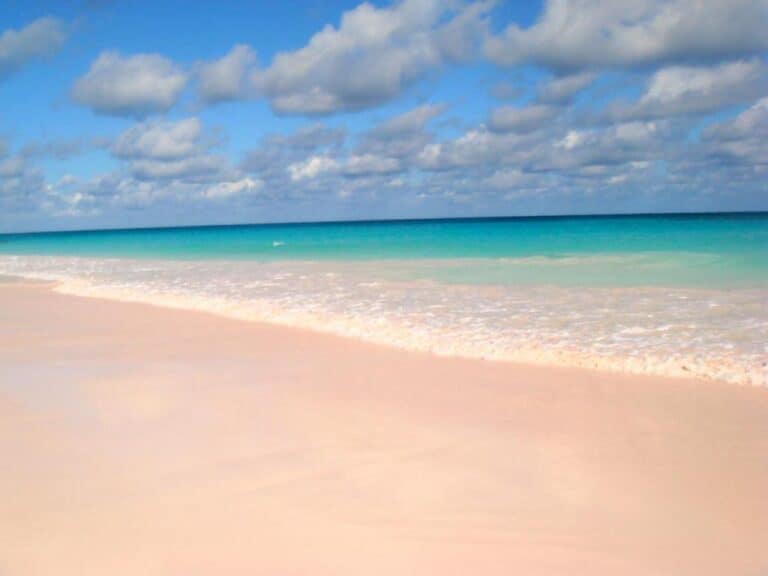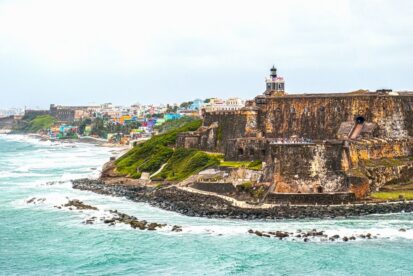
The Bahamas are off of Florida’s coast, a chain of about 2,400 cays and 700 flat coral islands covered with scrub and casuarina pine trees. The beautiful sandy beaches and azure seas that encircle the islands are the natural attractions. Being so close to the States, I am shocked I have not visited more. I remember going and visiting the Atlantis Resort, a complex of hotels, casinos, and Disney-like attractions with the theme of Atlantis, the legendary underwater city. During my time at the amusement park, I recall standing in the resort grand entrance as a parade of contestants for Miss Universe strutted by.


English is spoken on virtually every island in The Bahamas, but like almost every Caribbean island, The Bahamas has its own creole dialect. While British English is the official language, you’ll also hear accents and words or phrases influenced by various African languages.

Bahamian dollars (BS$) and US dollars (US$) are equal and interchangeable throughout the country.

U.S. citizens are generally required to present a valid U.S. passport when traveling to The Bahamas, as well as proof of anticipated departure from The Bahamas. .S. travelers coming for tourism will not need a visa for travel up to 90 days. All other travelers will need a visa and/or work permit.

From utilizing public Wi-Fi, cellular data roaming from U.S. carriers, obtaining a local SIM card or personal satellite communicators – it’s entirely possible to cruise the Bahamas and keep abundantly connected. As you make your way through town, you’ll be able to use free cafe WiFi in many restaurants. National chains are more likely to offer free WiFi than local eateries. However, you may find some of them do.

Hotels $2 per bag is routine for porters. Restaurants A tip of 15% or so is standard, but it’s often added to your bill automatically – check before you pay. Taxis About 15% is the norm.

There are plenty of banks with ATMs in the major tourist centers, though they can be rare to nonexistent on the Out Islands. ATMs near the Nassau cruise-ship dock offer either BS$ or US$.

You don’t need a power plug adapter in the Bahamas when living in the United States of America. In the Bahamas, the power plugs and sockets are of type A and B. The standard voltage is 120 V and the standard frequency is 60 Hz.

The best time to visit the Bahamas is from mid-December to mid-April, the country’s peak season. Though temperatures here are great year-round (they rarely dip below 60 degrees), the islands fall within the hurricane belt, so hurricanes may be a factor between June 1 and Nov. 30 (the Atlantic hurricane season).
The best way to get around the Bahamas is by jitneys (or public buses). They are the most common form of transport from the country’s many airports – Nassau’s Lynden Pindling International Airport (NAS) and Freeport’s Grand Bahama International Airport (FPO). However, jitneys are not available on other islands (including New Providence Island’s adjacent Paradise Island), so to get around elsewhere, you’ll need to hail a taxi or rent a car. Traveling between Bahamian islands, meanwhile, requires flying from Nassau’s airport using the inter-island air service, Bahamasair, or hailing pricey water taxis. Some cruises and boat tours also make stops at multiple islands.
There’s no shortage of licensed taxis in Nassau and Freeport, where they can be hailed on the streets (many will actually hail you if you seem in need of a lift). Taxis are also the main local transportation in the Out Islands, where they meet all incoming planes and ferries in the larger settlements.
Nassau Streets are busy with jitneys (private minibusses) licensed to operate on pre-established routes, with fares ranging from $1.25 to $2.50. While jitneys nominally run during daylight hours, there’s no timetable, and some routes dwindle to nothing when the demand from local workers isn’t reliable. Freeport Has jitneys between Port Lucaya and Freeport, but services are scant and unreliable. Out Islands, No public transport: taxi, rental car and hotel shuttle are your only options.
Interisland flights offer the only quick and convenient way to travel within the Bahamas; islanders ride airplanes like mainlanders use buses. Private charter flights can be an affordable option for those traveling in a group – or they might be the only option for some more remote destinations.
Major international car-rental companies have outlets in Nassau, Freeport, and other tourist centers, and there are a host of local firms and individuals to choose from. It can be as casual as arriving at the airport and asking around for someone who knows someone, especially In the Out Islands. Ask at your hotel or look for display boards at the airport. Renters must be 21 (some companies rent only to those 25 or older), and collision damage waiver insurance is around $15 per day (smaller local companies may not offer insurance). Rates start at around $55 per day. Golf carts are popular on the smaller islands and cays and rent for about $50 to $70 per day.
Cycling is not particularly popular in the Bahamas. It’s not safe in traffic-clogged Nassau, though can be pleasant on Paradise Island, Grand Bahama, and the Out Islands. Many hotels rent cruiser bikes for about BS$15 a day; some let guests use them for free.
Despite the ferry and water taxi routes, island hopping in the Bahamas can be very difficult, time-consuming, and expensive. Water taxis provide short service between Nassau and Paradise Island and are common throughout The Out Islands. The most popular inter-island ferry service is Bahamas Ferries, which offers service from Nassau to Harbour Island, Eleuthera, Grand Bahama Island, The Abacos, Long Island, Andros, and The Exumas. One-way fees for adults range from $29 to $81, while rides for children ages 11 and younger cost $16 to $57. Round-trip fares are also available. Tickets can be purchased in advance on Bahamas Ferries’ Book Now page.
The Bahamas has a great tradition of delicious local dishes, featuring ingredients like guava, rock lobster, and conch. Bahamian cuisine is influenced by the dishes and cooking style of the American South, which is evident in the side dishes and seasoning used. Grits are common, as is a considerable amount of spice. There are some elements of Bahamian cuisine that are similar to cuisine throughout the Caribbean, such as fresh seafood, peas n’ rice, and some that are unique to the islands of The Bahamas.

The Bahamas offers a wide selection of accommodations, ranging from small private guesthouses to large luxury resorts. Hotels vary in size and facilities, from deluxe (offering room service, sports, swimming pools, entertainment, and so on) to fairly simple inns.


Atlantis Paradise Island is an ocean-themed resort in Paradise Island in the Bahamas. It features a variety of accommodations built around Aquaventure, a 62-hectare waterscape, which includes fresh and saltwater lagoons, pools, marine habitats, water slides, and river rides.

Located in the heart of Nassau, Ardastra Gardens, Zoo, and Conservation Center is a unique attraction that is home to the well-trained, world-famous marching flamingos. Its mini zoo has more than two hundred mammals, birds, and reptiles that are nestled in over four acres of lush, tropical landscape.

Harbour Island lies just northwest of Eleuthera Island in the Bahamas. It’s known for the long pink sand beaches stretching along its eastern shore. The west coast also has beaches and several marinas. Outlying coral reefs like the Devil’s Backbone are home to marine life such as stingrays and turtles. The main hub, Dunmore Town, features pastel houses like the 1797 Loyalist Cottage.

Inhospitable caverns just beneath this island paradise offer insights into alien worlds. Just below the turquoise water and balmy sea breezes that make visitors lament not being able to stay forever, one of the harshest environments on the planet exists. “Blue Holes,” as they are often called due to the small circle of water they form in the inland soil (and their similarities to the more well-known offshore variety), sometimes form the entrance to a vast network of underground caverns. The caverns are completely submerged and contain zero or near-zero percent oxygen – and that’s just the first of their remarkable traits.

The world’s largest underwater sculpture is found just off the coast of Nassau. Artist, photographer, naturalist, and diver Jason de Caires Taylor introduced his record-breaking public sculpture to the crystal Bahamian waters in 2014. Entitled Ocean Atlas, the installation encourages coral colonization and deters tourists from endangered reefs.

Hand-carved from solid limestone rock by 600 enslaved people, the Queen’s Staircase was built between 1793 and 1794 to provide a direct route from Fort Fincastle, a battery protecting the entrance to Nassau Harbor (notorious in that era for attracting pirates and geopolitical intrigue) to the central part of the Bahamian capital.
Accommodation:
Hotel or Hostel (single): $36
Double-occupancy room: $71
Food
Meals for one day: $19
Transportation
Taxis, local buses, train: $11
Intercity: $39
Taxi from airport: $30
Water taxi: $8
Taxi to Cable Beach: $35
Entertainment
Entrance tickets & shows: $10
4-Hr Kayak Tour: $70
1/2-Day Snorkel Trip: $75
10-Dive Package: $299
Jet ski: $50
Tips & Handouts
Guides & service providers: $12
Alcohol
Drinks for one day: $5.91
Cocktail: $6.50
Accommodation
Hotel or rental home (single): $85
Double-occupancy room: $171
Food
Meals for one day: $42
Transportation
Taxis or Car rental: $26
Intercity: $108
Taxi from airport: $30
Water taxi: $8
Taxi to Cable Beach: $35
Entertainment
Entrance tickets & shows: $26
4-Hr Kayak Tour: $70
1/2-Day Snorkel Trip: $75
10-Dive Package: $299
Jet ski: $50
Tips & Handouts
Guides & service providers: $13
Alcohol
Drinks for one day: $13
Cocktail: $6.50
Accommodation
Resort or hotel (single): $188
Double-occupancy room: $376
Food
Meals for one day: $76
Transportation
Car Rentals or private driver: $57
Intercity: $329
Taxi from airport: $30
Water taxi: $8
Taxi to Cable Beach: $35
Entertainment
Entrance tickets & shows: $67
4-Hr Kayak Tour: $70
1/2-Day Snorkel Trip: $75
10-Dive Package: $299
Jet ski: $50
Tips & Handouts
Guides & service providers: $13
Alcohol
Drinks for one day: $25
Cocktail: $6.50
When planning for your trip to The Bahamas, don’t forget about travel insurance! You never know what might happen and it’s better to be safe than sorry.




Interested in traveling the world while getting paid? Here at Diversifying Globetrotters LLC, we are partnered with Melanin On The Map and Travel Coach Network to help people across the world find financial, personal, and time freedom. Join the hundreds of others making the change to better themselves while exploring the world and adding money to their pockets.